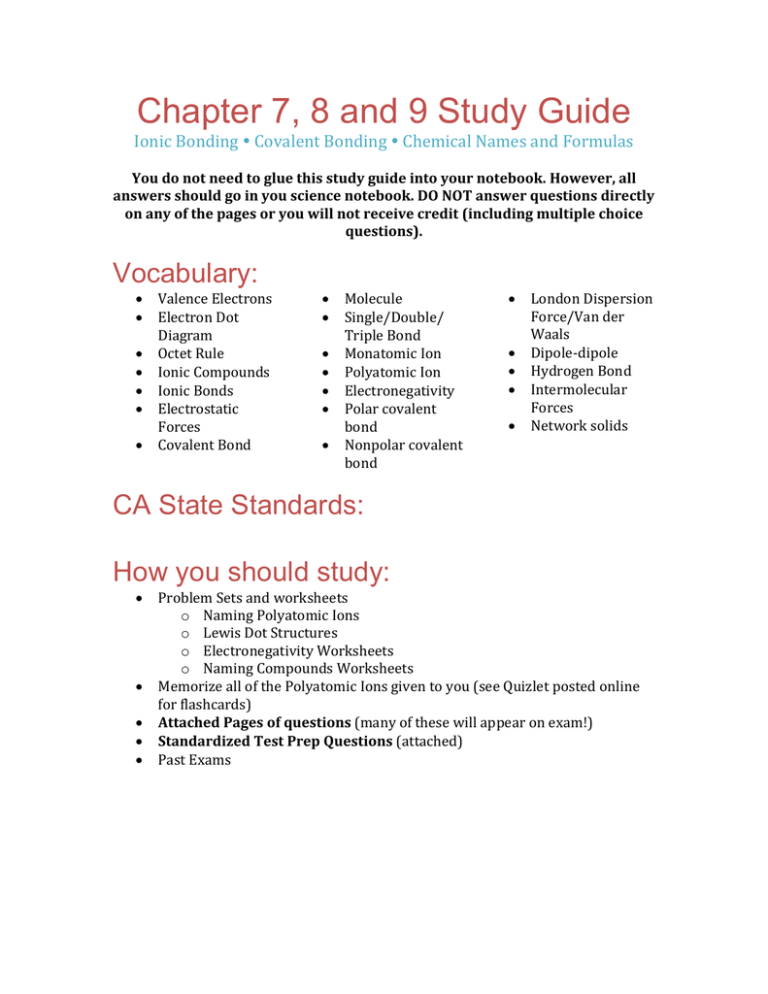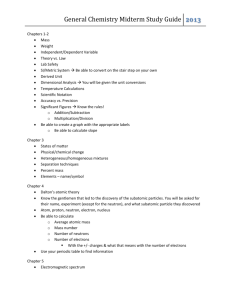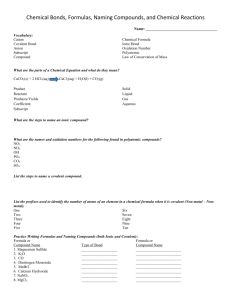Chapter 7, 8 and 9 Study Guide Ionic Bonding Ÿ Covalent Bonding
advertisement

Chapter 7, 8 and 9 Study Guide Ionic Bonding Covalent Bonding Chemical Names and Formulas You do not need to glue this study guide into your notebook. However, all answers should go in you science notebook. DO NOT answer questions directly on any of the pages or you will not receive credit (including multiple choice questions). Vocabulary: Valence Electrons Electron Dot Diagram Octet Rule Ionic Compounds Ionic Bonds Electrostatic Forces Covalent Bond Molecule Single/Double/ Triple Bond Monatomic Ion Polyatomic Ion Electronegativity Polar covalent bond Nonpolar covalent bond London Dispersion Force/Van der Waals Dipole-dipole Hydrogen Bond Intermolecular Forces Network solids CA State Standards: How you should study: Problem Sets and worksheets o Naming Polyatomic Ions o Lewis Dot Structures o Electronegativity Worksheets o Naming Compounds Worksheets Memorize all of the Polyatomic Ions given to you (see Quizlet posted online for flashcards) Attached Pages of questions (many of these will appear on exam!) Standardized Test Prep Questions (attached) Past Exams Study Guide Part 1 Chapter 7: Ionic Bonding 1. Write the symbol of the ion formed when: a. A sulfur atom gains two electrons b. A aluminum atom looses three electrons 2. Atoms of which elements tend to gain electrons? Atoms of which elements tend to lose electrons? 3. How do cations form? 4. How do anions form? 5. How many valence electrons are in each atom? a. Potassium c. Carbon b. Magnesium d. Oxygen 6. Draw the electron dot structure for each element in Question 5. 7. How many electrons will each element gain or lose in forming an ion? a. Calcium (Ca) c. Fluorine (F) b. Aluminum (Al) d. Oxygen (O) 8. Write the correct chemical formula and name for the compounds formed from each pair of ions. a. Potassium and Sulfur c. Calcium and oxygen b. Sodium and Oxygen d. Aluminum and Nitrogen 9. Write the formulas for each compound. a. Barium chloride c. Lithium oxide b. Magnesium oxide d. Calcium fluoride 10. Which pairs of elements are likely to form ionic compounds? 1. Cl, Br 2. K, He 3. Li, Cl 4. I, Na 11. Hypothesize as to why ionic compounds conduct electric current when they are melted or dissolved in water? 12. Describe what is meant by ductile and malleable. (Vocab words from previous chapter) Study Guide Part 2 Chapter 8: Covalent Bonding 1. Draw the electron dot structures for each atom: a. Chlorine b. Bromine c. Iodine 2. The following molecules have single covalent bonds. Draw an electron dot structure for each. a. H2O2 c. PH3 b. PCl3 d. ClF e. H2S 3. Draw the electron dot structure of: a. Hydroxide ion. b. The polyatomic boron tetrafluroide anion (BF4-) c. Sulfate (sulfur is the central atom) d. Carbonate (carbon is the central atom) e. The bicarbonate ion. Carbon is the central atom, and hydrogen is attached to oxygen in this polyatomic anion. 4. Draw the electron dot structure for each molecule. Identify polar covalent bonds by assigning slightly positive (δ+) and slightly negative (δ-) symbols to the appropriate atoms within the molecule. a. HOOH c. HBr b. BrCl d. H2O 5. Name the intermolecular forces at work in question 4. 6. The bonds between the following pairs of the elements are covalent. Arrange them according to polarity, listing the most polar bond first. Use the periodic table from the electronegativity worksheet if needed. a. H—Cl c. H—F e. H—H b. H—C d. H—O f. S—Cl 7. What is a hydrogen bond? 8. Although the relative positions of the atoms are correct in each of these molecule there are one or more incorrect bonds in each of the electron dot structures. Identify the incorrect bonds. Draw the correct electron do structures for each molecule. (::: is a triple bond, : is a lone pair of electrons) a. H=C=C=H c. :I:::Cl b. :F—O—H d. H—N:::N—H 9. Why do compounds with strong intermolecular attractive forces have higher boiling points than compounds with weak intermolecular attractive forces? Study Guide Part 3 Chapter 9: Chemical names and formulas 1. Write the formulas for compounds formed from these pairs of ions. Then name them. a. Ba2+, S2e. NH4+, SO322+ 3b. Ca , N f. Calcium ion, phosphate + 2c. Li , O ion d. Cu2+, I- (Copper makes a 2+ and 1+ ion) 2. Write the formulas for these IONIC compounds: a. Sodium iodide h. Strontium oxide b. Potassium sulfide i. Lithium sulfate c. Calcium iodide j. Chromium (III) nitrite d. Tin (II) chloride k. Sodium chlorate e. Beryllium chloride l. Magnesium bicarbonate f. Cesium sulfide m. Calcium acetate g. Sodium iodide 3. Identify any incorrect formulas. Explain your answer. a. Mg2(SO4)3 c. Rb3As b. BeCl3 d. NaF 4. Write the names of these molecular (covalent) compounds. a. NCl3 e. N2H2 b. BCl3 f. N2O3 c. NI3 g. CS2 d. SO3 h. Cl2O7 5. Write the formulas for these molecular compounds. a. Phosphorus e. Carbon tetrabromide pentachloride f. Diphosphorus trioxide b. Chlorine trifluoride g. Boron Trichloride c. Iodine dioxide h. Dinitrogen tetrahydride d. Nitrogen dioxide 6. What prefix indicates each of the following numbers of atoms in the formula of a molecular compound? a. 3 d. 5 b. 1 e. 4 c. 2




